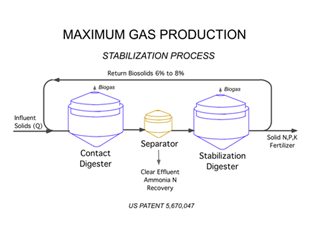Maximum Solids Conversion To Gas
Maximum conversion of volatile solids to gas is achieved with the stabilization process. The stabilization process can achieve the highest SRT / HRT ratios and consequently the largest reductions in anaerobic reactor size. The process is ideal for waste streams such as swine waste or flush dairy waste that contain rapidly degrading constituents and slowly degrading particulate matter.
In the process the influent waste is blended at a desired ratio with highly concentrated anaerobic bacteria prior to entering a contact digester. The easily degradable components of
the waste are converted to gas in a low detention time contact reactor (2 to 8 hours). The slurry is then separated producing a clear effluent and thick solid slurry of anaerobic bacteria
and partially degraded solids. The thick, low volume, slurry is then transferred to a long detention time stabilization digester where sufficient time is provided for the conversion of
slowly degradable particular matter to biogas.
Existing digester systems can be modified to maximize solids conversion to gas, or increase the waste loading, by simply adding the separator to existing digesters. The volume of the contact digester may be
the same as the stabilization digester with the contact digester receiving a much higher flow rate.
